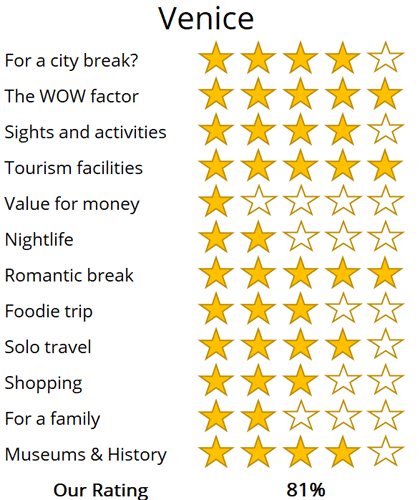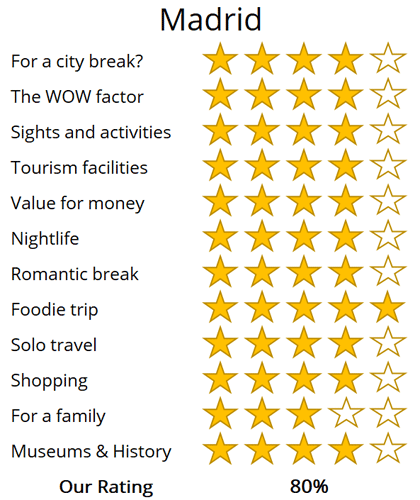WhereToGoForMyHoliday.com
The best destination comparison site!
WhereToGoForMyHoliday.com
The best destination comparison site!
Venice or Madrid, which is better for your holiday in 2024?
Madrid and Venice are fantastic cities, but which is better for your city-break or holiday?
We understand your dilemma. There is an abundance of travel guides for both cities, but few actually comparing them, and advising you which is the better for your trip.
This article will provide our unbiased and independent views of Madrid and Venice, hopefully making your choice that little easier.
The article is structured into several sections, each of which can be directly accessed through the following links:
• Introduction to the cities
• Scores and ratings
• Which one should I, friends, or family visit?
• When to visit and weather
• Who is the city suited for?
• The perfect 48hours (with map)
• Tourism details (where to stay? airport details?)
Introduction to Madrid and Venice
Being the original artisan city of western Europe, Madrid’s galleries and museums are unrivalled, and are a staple for any cultural holiday.
However beneath this formal exterior is a young and passionate city, with thrilling nightlife, delicious food and genuinely welcoming locals.
The visitors who rave most about Madrid are the long-stay residents – and there is something captivating about the city. The Museo del Prado, the Reina Sofía and the Bernabéu Stadium, for a different type of culture. Just avoid Madrid in August, when the entire city shuts down for the summer holidays.
Ah, Venice – a bucket-list city if there ever was one! Famed for its myriad canals, vast plazas and grand churches, this is one of Italy's most visited destinations.
Once the epicentre of its own trading empire that stretched right across the Mediterranean and even east to the Old Silk Road, it became rich on spices, precious metals, and cloth. These days, relics of that golden age remain. See them rise with the Orientalist spires of Saint Mark's Basilica. See them in the opulent interiors of the endless Doge's Palace.
But Venice is still a thriving town, not just a museum piece. Ferry boats weave through the Grand Canal and under arches where Canaletto and Monet once painted. Ice-cream parlours spill onto the narrow streets of Cannaregio. Pizzerias meet buzzy student bars scented with grappa around the Campo Santa Margherita. Yep, there's oodles of life left in this old seafaring dame!
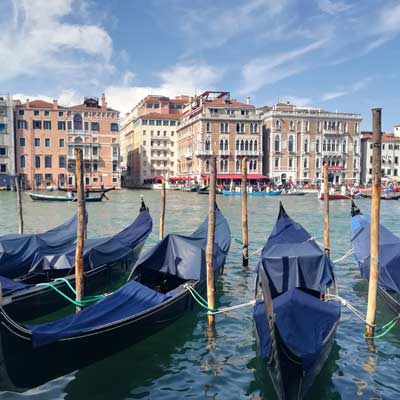
Grand Canal and gondolas waiting for the rush of tourists

The Plaza Mayor and the historic centre of Madrid
Madrid VS Venice: City Ratings
Summary
Where would I journey for a personal escape?
Madrid
Where would I send my parents for a memorable visit?
Madrid
Where's the ideal destination for my adventurous 19-year-old cousin?
Madrid
Where should my food-obsessed friend indulge their culinary passions?
Madrid
Note: The above comparisons are weather-independent and are based on travel during the most opportune times of the year. Details about the ideal travel seasons are elaborated upon later in this article.
In the sections that follow, you'll find a comprehensive comparison between these two fascinating cities. This includes recommendations on the duration of stay, the best times to visit, and tailored 48-hour itineraries for each city.
The final segment delves into practicalities for your travels, such as the best airport to fly into, the optimal districts for your accommodation, and insider tips, for when you come to explore the city.
We hope that you find all of this information useful, in planning your next exciting trip!
Destination details
How long to spend each city?
It's no secret that most people whiz in and out of Venice on big cruise ships, even if recent regulations are bringing a slow end to that.
Lots of weekenders also come on low-cost flights – Venice's Treviso Airport is a major hub for budget airlines like Ryanair and Easyjet. Those sorts of travellers can only ever really expect to scratch the surface of what's on offer.
The upshot? If you really want to explore this amazing city, you're going to need a little longer. If the budget allows, a week is perfect. That will be enough to see the mainstay sights, but also venture across to Murano and the Venice Lido, the party bars of Campo Santa Margherita, and the pathways of Giudecca.
For Madrid, the length of stay greatly depends on how much you want to devote to visit the three famed art galleries (Prado Museum, Thyssen-Bornemisza and Reina Sofía), or immerse into Spanish culture. The city can be seen in two days of sightseeing, and a third day is often given to the galleries.
There are many outstanding day trips from Madrid and a trip can be easily extended to 5 or 6 days. A selection of the best day trips includes the medieval town of Segovia, charming Toledo, and the magnificent El Escorial. Madrid makes for a good base from which to explore the region, and is served by inexpensive public transport

The Arsnal was the shipyard of Venice, which at its height could construct a boat in a single day
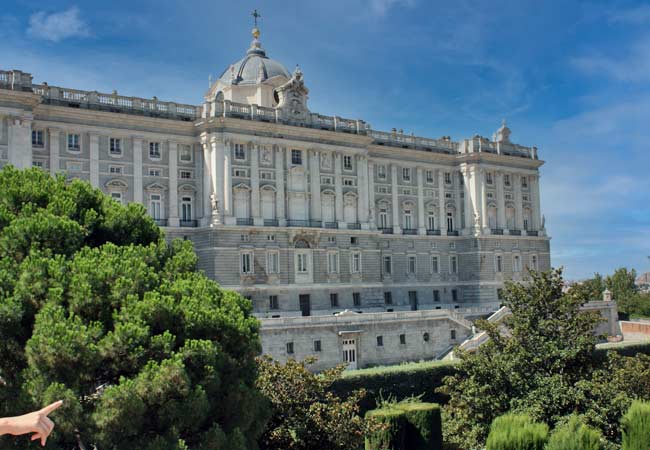
The magnificent Palacio Real in Madrid
We're almost tempted to say forget Venice in the summer entirely. During the Italian high season between May and August, the whole place is packed to bursting with tourists. You can barely swing a slice of pizza on the Rialto Bridge or down on Piazza San Marco.
What's more, the horizon is tainted with the outlines of huge cruise ships.
Far better are the shoulder months of May and September. The crowds diminish considerably during those, but the weather still tends to be reasonable – think daytime temperatures regularly hitting the mid-20s.
The final weeks of February are also popular on account of the centuries-old tradition of the Venice Carnivale. Come then to join the revelry but be sure to bring along a flamboyant face mask (a must) and a good coat, because the winters can be cold.
It's probably a good idea to avoid the rest of the winter. Venice is one of the lowest-lying cities in the world, so flooding comes easy. In the last few years, there have been huge problems with water clogging up even the famous tourist hotspots around Piazza San Marco.
The major consideration for Madrid, is to avoid August. The entire city shuts down for the month, and everyone heads to the slightly cooler coastal towns.
The best time of year for Madrid is late spring (Jun/Jul) or early autumn. Madrid can be surprisingly chilly in the winter, but is comparatively drier and milder than the rest of northern Europe. As Madrid is in the centre of the Iberian Peninsula, it tends to get more extreme weather than the coastal cities.
Madrid is one of the finest cities in Europe. The city may not have the iconic monuments and attention-grabbing tourist attractions, but in reality, there is a lot to see during a city break.
Much of Madrid’s tourist literature focuses on the museums and galleries (which are world-class), but this should not deter you; this is a fun-loving city, which has the best nightlife in Europe. No matter your style of trip, there will be something to love about the Spanish capital.
Madrid excels as a long-stay destination, and if you can work here, the city offers the perfect work/life balance.
Venice is a perfect break for those keen to check off another bucket-list city. Yes, it might be over touristed, but there's still something truly magical about the canals and the gondolas and the great churches here.
It's simply unlike anywhere else on the planet. All that adds an edge of romance to boot. So, consider this one if you're searching for a city-based honeymoon.
On the flip side, Venice isn't for the budget traveller or the outdoorsy person. Yes, you can hop on a bus to go north to the Dolomites, but they are still several hours away.
There are beaches, but they are nowhere near the best on the Italian east coast. And you can expect to pay over the odds for virtually everything, from hotels to ice creams to pizza.

The Museo Nacional del Prado, is one of the finest art galleries in the world
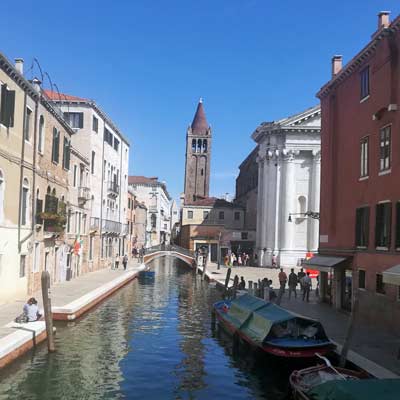
The pretty Ponte dei Sospiri and canals of Venice
48hours in Venice
Delve into the secrets and the uber-famous sights of Venice with this 48-hour itinerary. It will take you from the legendary walks of the Rialto Bridge all the way to the hidden glass workshops of Murano, revealing some of the most enthralling corners of the iconic City of Canals.
Day 1: Rise early and race to the Piazza San Marco. Beating the crowds to the vast plaza is a great way to see it in all its glory. As the sun rises, watch as the light caresses the red-brick Campanile (a 98-meter belfry dating from the 12th century) and the bulbous domes of St Marks Basilica.
If you've managed to arrive before the queues start to form, be sure to duck into the latter. It's free to enter and has intricate Byzantine apses and frescos. Right next door is the Doge's Palace. Again, if it's too late you can certainly expect a queue. If not, head behind the Gothic frontispiece to wander the old palace of the erstwhile leaders of the Venetian republic.
Then head north through the narrow alleys of the San Marco district. It's a beautiful maze of little side streets, occasionally punctuated by a watery canal. You're sure to find a cafeteria there for lunch, before you go straight for the Rialto Bridge, made famous by Shakespeare and painters. Cross it and hit the buzzing markets of Ruga dei Oresi, which abut the small Campo Bella Vienna, a top spot to sit with a cold beer and watch elegant Venetian gondolas drift in and out of the canals.
If you choose not to ride one, you can push on to see the San Giacomo di Rialto (probably the oldest church in the whole city!) and then the neighbourhood around Campo Santa Margherita. That's a nightlife mecca, where you can unwind with a prosecco or ten.
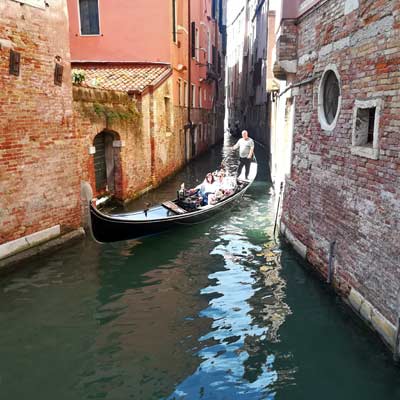
No trip to Venice is complete without a gondolas ride
Day 2: Your second 24 hours in Venice is all about hitting the different districts. We'd recommend starting on the northern side of the archipelago. That's home to characterful Cannaregio; the old Jewish Quarter. These days, it's got canal-side cafés next to the fascinating Muso Ebraico di Venezia, which tells the story of Venetian Jews over the centuries.
From there, move west to Santa Croce. Within, you'll glimpse the lived-in city. It's the only place where cars can travel on the archipelago and it has newer churches and loads of bakeries and shops. Hop the Grand Canal ferry (number 3) from there to Murano.
Pastel-painted workshops meet the water on that island, in an area that's been famed for centuries for its glass making. If you're interested, the Museum of Glass is a great place to start.
Alternatively, enjoy a lunch on the lagoon and then get back on the boat, travelling all the way through the Grand Canal to the Dorsoduro. The zone has beautiful broadside views of Piazza San Marco at sunset. It's also home to plenty of lovely osterias with northern Italian wines and delicacies to get stuck into.
Related articles: 48-hours in Venice

The vaporetti ferries are the best way to get a waterside view of Venice
Madrid
48 hours in Madrid is not just the sights but also the atmosphere of the city. Below is an interactive tour map - day 1 is highlighted in green and day 2 in yellow, with optional sights marked grey.
Day 1 - 1) Puerta del Sol 2) Plaza Mayor 3) Plaza de la Villa 4) Mercado de San Miguel 5) Plaza de Oriente 7) Palacio Real 8) Almudena cathedral 9) Basílica de san Francisco 10) Calle de la Cava Alta
Day 2 - 11) Prado museum 12) Thyssen-Bornemisza Museum13) Museo Nacional Reina Sofía 14) Parque de El Retiro 15) Puerta de Alcalá 16) Palacio de Cibeles 17) Gran Vía 18) Malasaña district 19) Plaza de España 20) Templo de Debod
The 48 hours in Madrid begins in the Puerta del Sol, then wanders through charming streets of the El Madrid de los Austrias, which is the oldest section of the city. This leads to the Palacio Real, surrounded by its formal gardens and the Catedral de la Almudena to the south.
For the last part of the day explore the La Latina district and have a delicious tapas meal at one of the restaurants along the Cava Alta or Cava Baja. La Latina boasts numerous bars and is always a great place to start a night in Madrid.
The morning of the second focuses on the three art-museums, the Prado Museum, Thyssen-Bornemisza and Reina Sofía. Close to the museums is the pretty the El Retiro Park.
For the afternoon head down the Gran Vía, the main shopping street of Madrid, and visit the Malasaña district, with its artisan vibe, independent shops and trendy nightlife. For sunset watch it at the Templo de Debod, and then head back to Malasaña for a memorable meal and evening.

The atmospheric Templo de Debod, is Egyptian temple which was moved to Madrid in 1968, due to the construction of the Aswan dam (which would have flooded the temple)

The Gran Vía is the bustling main avenue of Madrid
If you choose a good season to visit, then Madrid is ideal for a city break. There is just one airport severing Madrid and is only 13km from the historic centre. For onward travel take the metro (€1.50 single – 30 minutes). For flights, there is always high demand for Friday/Sunday flights to/from Madrid, so if planning a city break always book at least 6-8 weeks in advance.
On initial appearance Madrid seems to have ample supply of hotel and rental rooms, but this is slightly misleading, as the city is so sprawling.
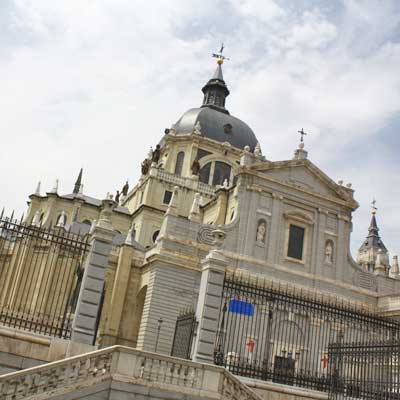
The Catedral de la Almudena
For your first visit, you would want to be based in the Centro or Retiro districts, and this will limit accommodation options. If you do wish a more remote, budget option always ensure it is close to a metro station. While exploring Madrid, you will do a surprising amount of walking.
Venice is largely safe and easy to travel. However, there are some things worth knowing before you go. First off, the overload of tourists has seen a huge spike in pickpockets over the years. So, always keep an eye on your valuables, especially in uber-popular spots like the Piazza San Marco and Erbaria.
Second, be wary that Venice's side streets are rarely empty. You'll always need to dodge a crowd and watch where you're walking. When it rains, flooding is common, so pack waterproofs and wellies if you're visiting in the winter months. Also, keep an eye out for pigeons. They're a nuisance on the piazzas and can even carry disease.
Navigating Venice isn't like navigating any other place in Europe. Taxis and buses simply don't exist – there are no real roads here, after all. Instead, you can make use of the ferries (known locally as vaporetti).
They run routes up and down the Grand Canal and out to other islands like Murano all throughout the day. They're actually a great way to see the main sights, with tickets for a full 24 hours costing as little as €20.

Rarely will you find a steet this quiet in Venice……
There are two airports serving Venice and its region. The largest and the closest to town is the international hub at Marco Polo Airport. That's got connections going all around the world. It's linked to the city by the ATVO bus (arrives at Piazzale Roma) and to the train station in Mestre.
If you're flying low-cost, it's more likely you'll arrive at Treviso Airport. That sits some 20 miles to the north, with buses that link to the archipelago in around 70 minutes for about €10 each way.
Choosing where to stay in Venice is very important. Fly-in, fly-out tourists will want to be in the vicinity of Piazza San Marco. The area is laced with expensive and classy hotels, but also has some more affordable options, all within walking distance of the top sights.
If to save some cash and get somewhere a little quieter, you could sleep closer to Dorsoduro or the Cannaregio, or even out in Murano. The cheapest places of all will be on the mainland, in Mestre.
Related articles: Where to stay in Venice?

oh we were stuck in the airport!

Copenhagen was a bit expensive...

All we did was drink beer in Brussels...

Muncih was crazy

And we got so burnt!

Remeber that night in Rome

oh we were stuck in the airport

So much fun kayaking

Berlin and that group from Austria!

There was such a view from that church

And we got so burnt!

Munich was eventful, wasn't it!

Such a view from that cathedral in Florence

Lisbon was such so much fun

Last summer was so much fun .... x

Remeber that night in Rome

Lisbon was such so much fun

Such a view from that cathedral in Florence

Munich was eventful, wasn't it!

And we got so burnt!

Remeber that night in Rome

All we did was drink beer in Brussels...

Berlin and that group from Austria!

Can't wait to go back to Dubrovnik

Remember that boat ride in Prague

Copenhagen was a bit expensive...
